#and instead they built the sphere
Explore tagged Tumblr posts
Text
Bad, paraphrased: it would be nice and help traffic if they had a bunch of self driving cars that went around a loop picking people up and dropping them where they need
The chat:... do you mean a metro
#qsmp#badboyhalo#tbf he did say that public transport would be the best solution but that the government probably doesn't want to make a long term investment#and instead they built the sphere#and this is why i hate cars!
28 notes
·
View notes
Text

@dimiclaudeblaigan asked for a tutorial on how to begin drawing. Good news! If you can draw a funky looking stick man, you have already started!
I think that stick people are a great starting point for artists because of the things you can learn from them that will be important later on.
If you are able to draw a circle and a couple of lines, you can easily put together a stick person.

Congratulations! You have started to draw. :)
A stick person is a very minimal artistic representation of a real life person. It is simple yet recognizable, and is widely used in art, media, and signage.
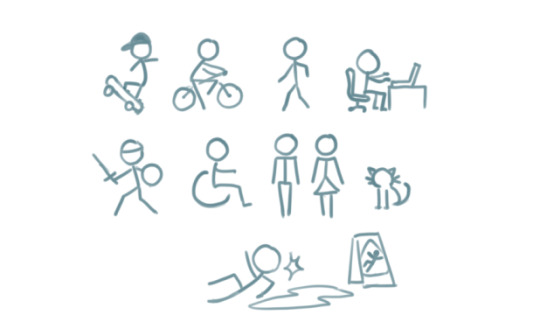
But what can a stick person teach us about drawing people that look more like… well, people? Lets have a look!
By simply adding a few more lines, we can add a pair of eyes and a mouth. Maybe even a little triangle nose! Or half circles for ears. We can now draw a face, which provides a basis for all sorts of expressions.
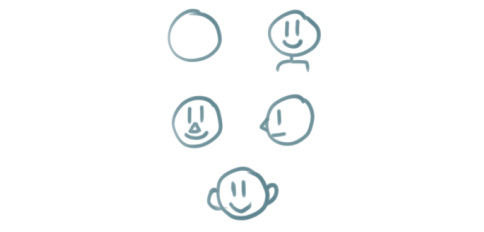
These simple additions can allow us to explore the wide range of human emotion and individuality.

This may seem like the basics of the basics. But that is what we want! In order to get to the point where we are able to draw complex, elaborate representations of humans and objects, we will need to start with simple shapes like lines and circles and build our understanding from there.
For instance, lets give our stick person some cool new features, such as hands and feet. I chose little squiggly circles to represent hands, and triangles to represent feet.
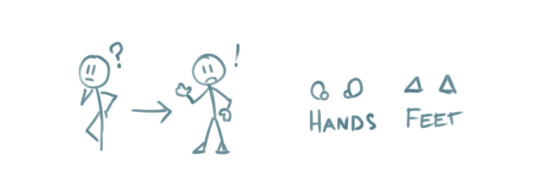
We can go a step further and modify the body of the stick person to include shoulders, hips, elbows and knees. These parts of the human body are quite complex in real life But here, all we need to do is add a few simple lines and dots to our stick person.

The lines provide some additional structural elements to our stick person's body, which are the shoulders and the hips. The dots indicate the points of articulation - elbows and knees, the places where the arms and legs bend!
Now we can use our stick person to show us an even wider range of human movement, action, and expression.
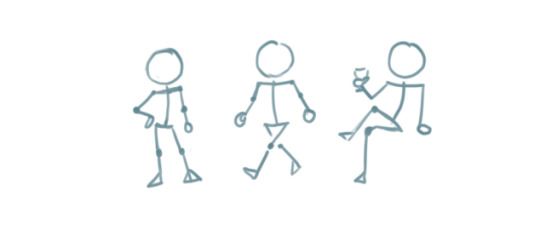
Our little drawing of a human being is evolving! All it took was adding a few more lines and shapes here and there.
By elongating some of the existing lines and making the head an oval instead of a circle, we can give our stick person proportions that resemble that of a real life human.
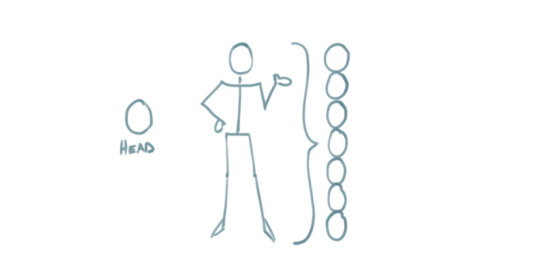
By this point, we have managed to add more complexity to our stick person simply by using our ability to draw lines, circles, and other basic shapes!
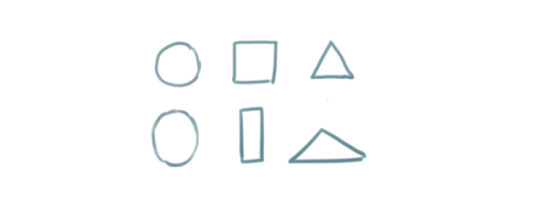
These basic ideas are the building blocks that will enable us to create more complex shapes.
The next part may be a considerable step up if you are absolutely new to drawing, but I have decided to include it in order to show you how complex objects like the human body can be built from shapes that are a bit more complex than circles and lines.
For example. Two ovals and a rectangle can be combined to create a cylinder.

Six squares can be combined to create a cube, or a box. Here, each square is distorted slightly depending on which way the cube is facing.

Note that the back faces of the cube and the bottom of the cylinder are hidden. These shapes allow us to visualize that which should not normally visible.
A sphere from all perspectives can be represented by a circle. But we can make it more like a sphere by adding lighting and shadow if we so desire.

Cubes, cylinders, and spheres are examples of 'solid shapes' because they consist of 3 dimensions.
Lets see how these solid shapes can be used to compose the human body.
By stacking three cylindrical objects, we can create a torso. Two spheres have been added to form shoulders, while a smaller cylinder forms the neck.

An arm is an alternating sequence of spheres and cylinders connected together. Note that the hand has been simplified for this example.
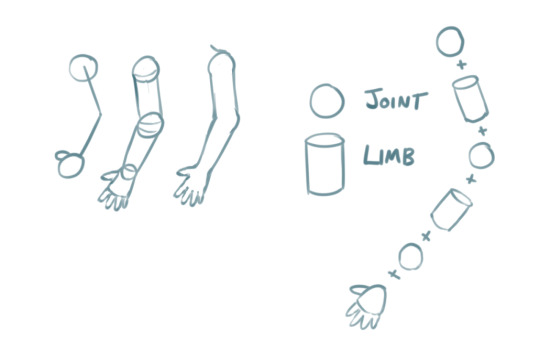
We can apply these solid shapes to the rest of the body to give us a more recognizable representation of the human form. It doesn't even have to be perfect. And just like that, our stick figure now has a silhouette that is unmistakably a person!
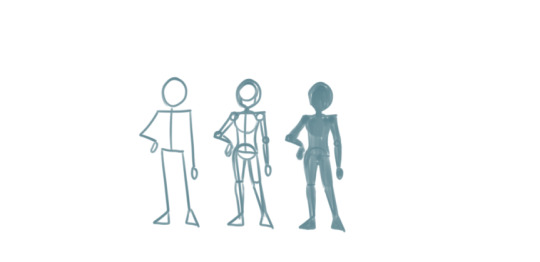
In the above examples, notice that we kept the stick person at the beginning while building up the shapes and solids around it. This is because the stick person serves as a guide for positioning the body and its various parts -> also known as posing.
You can do the same thing to everyday objects! Here, I drew a wine glass by stacking these three dimensional solid shapes.

The cup and its contents are two ovoid shapes that were cut in half. The stem is a very thin cylinder shape. The base is a cylinder with a slightly wider bottom.
Solid shapes help inform us how objects and parts of the human body may appear from different perspectives.
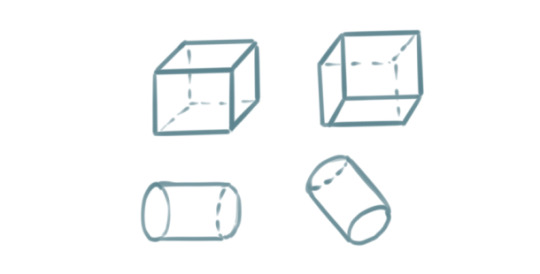
For example, a sphere can be used to demonstrate how the human head appears when looking up or down, turned to the side, or tilted at an angle.

With these examples, I hope I have managed to convinced you that if you can draw a circle and a couple of lines, you can draw a person! You just have to train your eye to recognize the simple shapes within complex objects. Try it with everyday objects as well! Or even your favourite media! A drawing subject can be as simple or as complex as you envision it to be.
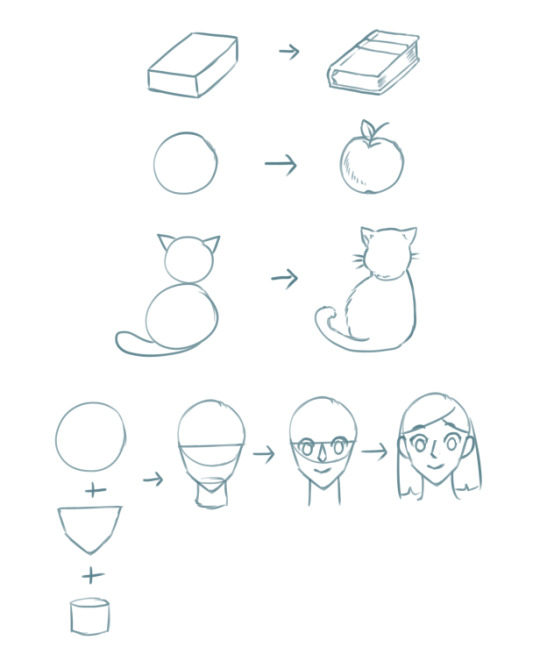
Once you have mastered that, there are many aspects of drawing you can explore from here that may require you to seek additional resources or a fellow artist's advice.

Last of all, remember that drawing is an iterative process. Even if you draw something correct the first time, you will need to draw it again and again to get it right all times! And by making small changes like the ones we explored in this tutorial, your drawings will gradually transform!
I hope what I've demonstrated here are enough to provide the basics of how to get started with drawing objects and people, and also to help refresh more experienced artists. :) Hopefully I didn't go too off topic with what was requested, and let me know if there are any more questions I can answer.
Cheers :3
28K notes
·
View notes
Text
South node & what you need to release
South node in 1st house- you need to release a part of yourself to be fully in a relationship. You need to put more of your energy into others. Be more comfortable with others. You also need to find your true self to actually find someone who is right for you. The problem with this south node is that the person likes to be alone and feels comfortable alone, but deep down they want someone. They seek connection with the wrong people and let people into their lives who are not good for them. They need someone who will truly see them for who they are. For you to truly find your person. You have to look within yourself.
South node in 2nd house- you have to let go of control, comfort, attachment to things. You are used to stability, security, comfort, luxury, money, material things. You can hold on to the things and people you love for a long time. You may have developed a strong attachment to financial security or to defining your value through what you own or how others perceive you in a concrete way. The North Node in the 8th house pushes you toward inner transformation, trusting more in emotional depth and connections with others. You’re meant to learn to let go, trust life’s flow, and accept that true value isn’t in material wealth but in deep connections, emotional growth, and transformation. True abundance comes from inner evolution rather than just financial or physical security.
South Node in 3rd house- you have to let go of your past life patterns (or karmic tendencies) revolve around intellect, communication, logic, and gathering information. You may have been someone who relied heavily on the mind, facts, and constant learning, but without diving deep into true wisdom. You may have a habit of gathering endless information or overthinking things, but now it’s time to focus on deeper understanding rather than just facts. The 3rd house is linked to short trips, social interactions, and mental stimulation. If you’re always engaged in small talk or minor tasks, it's time to step back and focus on the bigger picture. You may have been comfortable with familiar ideas and local surroundings, but now you’re meant to explore new cultures, philosophies, and a broader spiritual or intellectual perspective.
South Node in 4th house -you have to let go the comforts of home, the environment you are used to, and you may have to become more alienated from your mother (your mother may have had a great influence on you when you were little and on your decisions). You may have been deeply attached to your past, your family, or the need for comfort and emotional safety. You may have had a strong attachment to your family, home life, or childhood patterns. Now, you're meant to create your own path rather than staying tied to old emotional dynamics. You may have spent lifetimes focused on family duties, caretaking, or your inner emotional world. Now, it’s time to prioritize your career, ambitions, and public legacy. The 4th house is a deeply personal and emotional space. If you’ve been too focused on personal matters, you need to step up and embrace responsibility in the professional or public sphere.
South Node in 5th house- your soul has already experienced themes of creativity, romance, pleasure, and self-expression in past lives. You may have been deeply immersed in self-expression, personal projects, or artistic pursuits, but now, the lesson is to share your talents in a way that benefits the collective rather than just for personal fulfillment. You have to let go of worries related to children and focus on your joy. It's time to move away from needing intense love affairs and instead focus on deeper, long-term bonds built on friendship and shared ideals. If you’ve been used to standing out as the center of attention, the challenge is to recognize that you don’t lose yourself by being part of something bigger.
South Node in 6th house-you have to let go of worries, over-analyzing, perfectionism. Worries about health or a general preoccupation with cleanliness and minimalism. You are probably very good at organizing, planning things, and you usually want things to go according to plan. It's good to let yourself know that you're not perfect and that things don't always have to be perfect. You may have spent lifetimes being highly disciplined, responsible, and focused on efficiency. Now, it’s time to let go of the idea that your worth is tied to how much you accomplish. You may have a habit of focusing on flaws—either in yourself or others. This lifetime is about shifting from judgment to compassion and seeing the bigger picture rather than just the details. This lifetime is about shifting from rigid control and practicality to deep surrender and trust in the unknown.
South Node in 7th house- you have to let go of relationships that no longer serve you and start to find who you are without the relationships you have in your life. You may have focused a lot on relationships and spent a lot of time in relationships and are used to always having someone, but in this case, your goal is to find yourself without a partner. Not caring about the needs of others but serving yourself. It's time to release the fear of disappointing others and focus on your own desires. However, your soul's growth now comes from embracing independence and learning that solitude is where you discover your true self. The lesson here is to stop relying on others to affirm your worth.
South Node in 8th house- you are used to transformations, intense things, deep relationships. In past lives, you may have been financially, emotionally, or energetically tied to others, relying on their resources or support. Now, you are meant to build your own stability and wealth rather than depending on external sources. The 8th house deals with endings, trauma, and deep emotional experiences. You may have had past-life experiences of loss, power struggles, or intense transformations. Now, your soul craves peace, security, and steadiness, rather than dramatic ups and downs. The 8th house is connected to deep emotional bonds, sometimes to the point of obsession. You may have a history of toxic relationships, karmic entanglements, or emotional extremes, and now, you're meant to learn self-worth, self-reliance, and emotional stability.
South Node in 9th house-your soul has spent past lives (or early in this life) focused on seeking truth, higher knowledge, travel, and philosophical exploration. You may have a tendency to always look at life in a broad, philosophical way, but now, you’re meant to focus on the details and practical knowledge rather than abstract ideas. In past lives, you may have been a traveler, a scholar, or a spiritual seeker who moved from place to place in search of wisdom. Now, it's time to find meaning in your immediate surroundings, everyday conversations, and personal experiences rather than always looking outward. In past lives, you may have walked a solitary path, seeking truth in foreign lands or through intellectual pursuits. Now, you are meant to engage with your local community, form meaningful conversations, and share knowledge in a way that connects people.
South Node in 10th house- you may have built your identity around success, recognition, and achievements. Now, your path is about finding fulfillment within, rather than relying on career or public image for validation. In past lives, you may have been extremely ambitious, prioritizing work and public life over personal matters. It’s time to release the need to prove yourself through constant productivity and focus on emotional well-being instead. Now, you are meant to embrace your emotions, heal family wounds, and create a safe space for yourself. – In past lives, your soul may have prioritized external accomplishments over home and relationships. This lifetime teaches you that personal connections and emotional stability matter more than public success.
South Node in 11th house-you may have spent lifetimes being deeply involved in social causes, communities, or large networks. While this gave you a sense of belonging, you are now meant to focus on your own individuality rather than blending into a group. Now, your soul’s path is about following your heart, embracing joy, and allowing yourself to create without overanalyzing. You might have a habit of prioritizing friendships or collective goals over personal relationships. In this lifetime, you're meant to embrace romance, intimacy, and the vulnerability that comes with deep personal connections. Your challenge is to stop waiting for “someday” and allow yourself to live fully in the moment. You may feel more comfortable working behind the scenes or as part of a team. But now, you're being called to step into the spotlight, embrace your uniqueness, and let your creative energy shine.
South Node in 12th house-In past lives, you may have been a mystic, monk, or someone who lived in retreat from society. You may naturally withdraw from the world, but this life is about engaging in the physical world and being of service. Now, you're meant to ground your spiritual wisdom in daily routines and structured habits instead of floating in the abstract. The 12th house is tied to past-life karma. You may feel like you have an unseen weight on your shoulders or a subconscious sense of guilt. In this lifetime, you are not meant to sacrifice yourself but to serve others in a balanced, healthy way. You may have a habit of avoiding structure, discipline, or the details of daily life. Your soul is now learning the importance of commitment, routine, and practical efforts that lead to real-world results.
-Rebekah 🧜🏻♀️💗
955 notes
·
View notes
Text

“The Sphere”
Leonarda H. and her younger sister, Agnellia H. Two months prior to Leonarda murdering their father and her husband leading to the fall of their family name.
“<…> Some might say it was a troubling thought to even imagine being born into this system as a female when the sole purpose of their existence in the society was built upon the possibility of bringing to life the new Messiah of the Brightest Star. The others, though mainly those who were questionably happy enough to be born exactly where they were to be appropriately influenced, felt otherwise. <…> Giving the circumstances it would be fair to mention that although treated like the one and only remaining connection to what’s holy when it came to reproductive organs, the whole being attached to these organs rarely stood on the same pedestal. Instead, these well-dressed women clad in golden jewellery were poorly educated and hidden from one another even when it meant being hidden from their own families. <…> All of this merely to prevent the exact opposite manner of thinking — that they were more than trophy incubators in the fight for delivering the new Messiah.”
#artists on tumblr#art#digital art#character design#original character#my art#character art#character illustration#ocs#oc art#martyfive ocs
362 notes
·
View notes
Text
Pearl
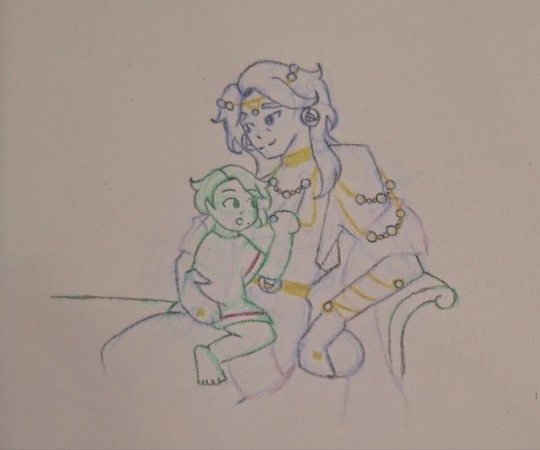
When Telemachus had been born, one of many things that had amazed Odysseus was the sheer amount of unfiltered strength those pudgy little fingers had.
They could barely wrap around his finger. Yet, before long they were fisting Penelope's beautiful dark curls, her dangling earrings and shiny necklaces whenever they were within reach. Once, he even fisted a corner of Odysseus' himation and gnawed on it like the goats of his homeland.
That particular habit stuck long after Odysseus was forced to relinquish the beloved himation woven by his wife for the silks and baubles of a prized possession. He had worried that the hard pearls and cold metals would make his son uncomfortable in his embrace but much to his relief, the child didn't care.
Instead, Telemachus was constantly fiddling with the jewelry, stroking rows of pearls strung upon golden chains and tracing the artful lines of a rose emblem's many petals. How ironic, that the adornments he resented for marking him as a leashed beast also gave him the perfect excuse to keep his son close.
Today was no different, for his son remained transfixed on a pearl nearly as big as a thumbnail. At least it was on a looser necklace that gave Odysseus some leeway.
After failing to divert Telemachus' attention back to the ball he'd been bouncing, Odysseus huffed and reclined on the kline to settle his son more comfortably on his lap.
"Puh." Telemachus babbled.
"Pearl." Odysseus corrected. "Say it with papa, pearl." he repeated, showing his son how to roll his tongue.
"Paaaaaaa." Telemachus said, sticking his tongue out exaggeratedly.
Odysseus laughed, bouncing his wonderful boy on his lap, eliciting excited squeals.
"Funny little wolf." Odysseus cooed, booping his little nose.
"Wuf! Wuuuuuuuuuuuu~" Telemachus giggled.
Odysseus kissed his chubby cheek. How he wished to bottle this moment into an amphora, how he yearned to turn every ounce of his son's happiness and innocence into a wine for Penelope to savour upon their reunion.
Oh Penelope..........
"Papa." Telemachus yanked his necklace. "Puh!"
"Yes, a pearl. You like those, hm?" Odysseus brushed his curls aside, the once fine wisps growing thicker as his body grew heavier. "They come from the ocean. It has many things; fish, coral, boats and islands. That is where we’re from, an island called Ithaca, with the bluest seas and a home on the highest hill.”
This was an old story he has told countless times, and he tells it once more with the same gravitas as the first. He tells his son of the sun-warmed rocks he and his sister raced across to catch birds, silver fishes hauled in nets, goats he helped herd, houses he and his father built, and an olive tree turned bed, its very roots a symbol of his parents’ everlasting love.
And though he has neither loom nor the skill, he weaves a new story for Telemachus. A sunny day, two sets of footprints across white sands, his mother’s weaver hands in his, only just cleaned of resin from fixing a boat.
“We decided to swim. And even if your mother wasn’t half-naiad, even if she had asked for the clouds themselves, I would have said yes without hesitation. And so we swam like fish and splashed one another like children. Then I dove down, down, down until I found a clam.
“I shucked it open then and there and inside, I saw it. A pearl.” he closed his eyes, remembering how he had almost dropped the treasure in his excitement.
“Puh.” Telemachus held up the pearl in his grasp.
Odysseus stared at it, unimpressed. It was a perfect sphere with a smooth lustrous surface that shimmered pink in certain angles. This one little ball alone could feed a small family for at least a month.
It was pretty and perfect, just like him.
It was not beautiful.
It was worthless, in his eyes.
“The pearl I gave your mother was different.” he placed his hand over Telemachus’ to hide the accursed gemstone out of sight. “It was beautiful, it was real and it-”
It was imperfect and oblong, coloured a slight bluish grey that reminded him of her keen eyes, the same ones Telemachus has.
Those very eyes stared at him, wide and trusting, as he waited for his father to finish his story.
“It was our love that made it a treasure. Had I given that pearl to anyone other than Penelope, it’d have as much worth as a pebble.” he finished.
Odysseus caressed Telemachus’ face and the boy gladly leaned into the familiar touch.
“I’ll teach you.” Odysseus promised. “How to swim, how to shuck clams, how to find the beauty in things that remind you of loved ones. I’ll show you a real pearl and help you find one yourself.”
“Papa…..” Telemachus yawned. Ah, yes, no matter the tale, storytime always ended in naptime.
Odysseus kissed the crown of his head. “Sweet dreams, my little wolf.”
Telemachus’ eyes fluttered closed and father and son both released the pearl from their hands.
The little boy dreamed of pearls while his father lied on the kline as if it were a raft desperately trying to keep them both afloat.
BONUS:
Rough full body ref of Odysseus' outfit. I kinda consider it a redesign of my first OoT design since it's more balanced & cohesive.
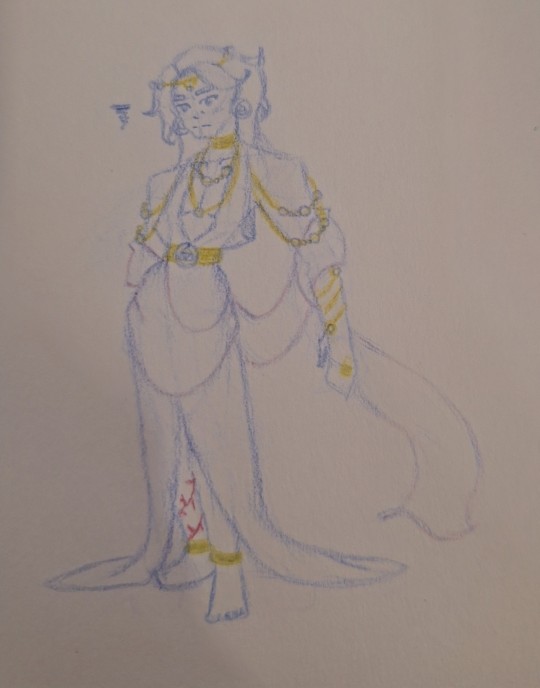
I also want to give thanks to @dkmbookworm, as my convos with her never fail to give me more inspo for this AU. If you're reading this dkm, I hope you liked this snippet I wrote!
#odysseus of troy au#odysseus#telemachus#me 🤝paris🤝aphrodite treating ody as our new favourite barbie doll#i know this isn't ao3 but comments & likes are still very much appreciated <333#i considered adding the veil buuuut i didn't want to make it too cluttered so i scrapped it#anyways enjoy!
98 notes
·
View notes
Text
Why Stolas's Story Is a Neurodivergent Story
And what that means for what's ahead.
Like a lot of fans, I see Stolas as autistic. This isn't a diagnosis post. But yes, something something special interests, dinosaur arms, persistent difficulty fitting in with his own social class, anxiety about social situations, frequent difficulty reading people and/or noticing others' emotions (especially when caught up in his own thoughts), masking, etc. etc. etc.
I want to talk about how Stolas's character arc tells a really well written (and potentially very uplifting) story about what it's like to be neurodivergent.
So what would be in my ideal neurodivergent story? Well I'd rather stay away from true utopia and have it reflect what it feels like to be neurodivergent in society today. So the character would struggle, not because their traits are bad, but because society isn't built for them. As the story progresses, the character might find happiness in unexpected ways and begin to look beyond society's rigid expectations for what a "good life" looks like. And then, hopefully, after some twists and turns, this character reaches a kind of self-acceptance where they are more themselves than ever, proud of who they are, and maybe even able to help change their society for the better.
Stolas's character arc IS this story.
Act 1: It's hard trying to fit into a neurotypical world.
Stolas is taught to mask his true emotions and follow strict social expectations as a child. He isn't living in just ANY neurotypical culture. The Goetia are old and set in their ways, and have rigid expectations for what one does and does not do. He's playing the social game on "hard mode" from the beginning.

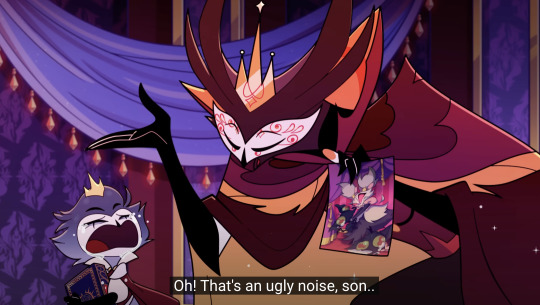
I think one thing that helps make Stolas high masking is the way in which his special interests are socially acceptable within his social sphere. Stars and plants? Books? Well he's a nerd, and no one wants to be his friend, but of course a guy with his particular destiny-assigned-in-childhood would like things like that.
Stolas develops a few different types of masks. One is the "I'm fine" mask where he pretends not to be emotionally affected by what's going on around him.

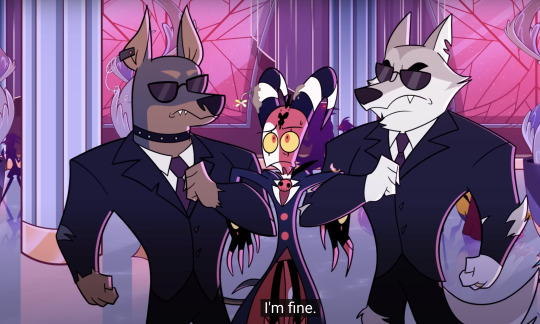

The other is this sort of "powerful" mask. A character who is in control of everything and plays into his society's ideas of how a Goetia should interact with the rest of the world. It usually means acting demeaning toward Blitz in order to preserve the facade of what a powerful prince of Hell is supposed to be. And he's conscious of putting on an act when he uses it.


But anyway, the masks cover up a person who is deeply unhappy in his prescribed role and doing his best to act correctly for others . . . his father's expectations and then his daughter's wellbeing, instead of for himself. I like that HB has him STILL not fit in among the Goetia despite his best efforts. It's an experience that a lot of neurodivergent people know too well.
By the way, I LOVE how Mastermind brings us Stolas doing something truly subversive with this "powerful" mask, playing into his society's expectations in order to, in a small way, undermine their power. BUT that's me getting ahead of myself.
Act 2: The neurodivergent character learns that there are other ways to be.
I think that Stolas has been dipping his talons into this part of his story for two seasons now but has been hesitant to envision himself as anything but a prince of hell. We're going to see him fully engulfed in working through these questions in Season 3 because of his banishment.
Blitz is of course the major catalyst for Stolas questioning his commitment to conformity and acting outright rebellious at times.
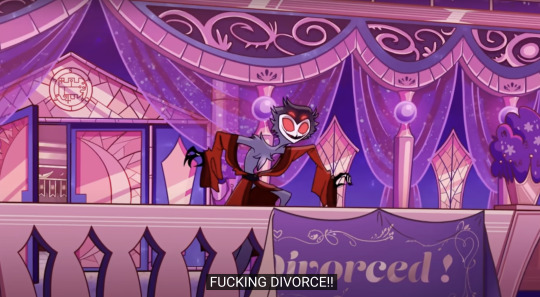
I think it's neat that Blitz is so clearly neurodivergent himself. We tend to find each other . . . if you're reading this and are neurodivergent, take a look at your closest friends. And these two share a kind of chemistry and appreciation for one another that most of Hell seems not to see in them.
BUT until he's banished, Stolas doesn't really reach for a situation where he doesn't need to act out his prescribed role. Even when he pursues a relationship with Blitz in earnest, he does so with the expectation that he'll somehow balance this relationship with satisfying the expectations of his upper-class peers.
Act 3: Radical Self-Acceptance?? Hopefully!
Now we can only speculate.
I think that despite realizing that he wants something else, Stolas still fundamentally believes that something is wrong with him. He doesn't understand yet that his enthusiasm for his interests and his emotiveness, for instance, are part of what makes him wonderful. He doesn't see yet that being different might even help him change a society that is deeply flawed.
I can't wait to see Stolas truly have fun in Imp City, and do things there that he's truly proud of.
Whatever happens with his literal powers, he might figure out that he's most powerful when he doesn't act like a "powerful prince" but instead acts like himself and proudly questions his society.
And there's a lot of "The Circus" in this post because @akirathedramaqueen and I had a major brainstorm while we were rewatching that episode. More new ideas about old material to come soon hopefully!
This post is a follow-up on this literal fever ramble from yesterday about Blitz as a neurodivergent character. And yes, I think neurodivergent stories map onto queer stories quite nicely.
#stolas#stolas goetia#stolitz#helluva boss#hb#my helluva meta#neurodiversity#helluva boss analysis#blitzø
85 notes
·
View notes
Text
Some thoughts for a D&D Spelljammer setting I'll probably never get around to actually write:
Spelljamming ships should be a revolution in transport and not only for fantasy space, they're basically flying ships, they could transport things from one end of a planet to another. Worlds that know spelljamming must be very different than those that don't.
What's the limitation here, then? Spelljammers themselves, that is, the guys who pilot the ships. They need to be magic users and you would need at least 2, preferably more, for shifts. That means you need to have mages that could be doing other useful magic stuff piloting a ship.
There's also the cost and skill required to make spelljamming helms. 5000 GPs in materials and level 5 spell apparently. Now, gold and levels in D&D don't mean much to me, so for the purposes of this scenario, I will assume making a spelljamming ship is costly and needs a lot of skill regardless of the actual numbers involved. So you don't have ships flying around the skies of every world, just a few have both the "human resources" (that is, trained mages) and material resources (I assume the spells and components are expensive and rare) to make spelljamming helms and crew ships.
Do we have equivalents of this in the real world? Yes, actually! The entire aircraft industry! Airliners, which are among the most complex machines produced in mass, are basically built only by Boeing, Airbus, and recently Comac on China (there used to be more) and pilots aren't easy to train either. There might be few worlds with the concentrated *productive forces* to build spelljammer helms in "serial" production, outside of some crazy wizard in a tower.
In fact, this is a bit besides the point but in general, the world(s) of D&D are pre-industrial, and this makes sense as for complex tasks you wouldn't really think of using a machine to do it, you seek a magic user who can do it instead. They are very jealous of their trade secrets too. We are looking at a kind of Renaissance economy in a large scale then, with guilds and church(es) and other institutions for "artisanal" complex goods instead of industries. Fantasy settings have always been strange about the demographics of mage users, but I think knowing the role of monasteries, alchemists, etc. during the real-life Renaissance helps you get closer to the dynamics.
Returning to the ships, I think spelljammer ships (or helms) might be hard to make but very hardy, long-lasting and easy to pilot, sort of like DC-3s that were built before WWII and are still used in Colombia. So that fits with the adventurer idea of getting an old ship and going into the stars. And maybe there is a surplus of them in some worlds that used to have large navies (like post-WWII surplus of airplanes and ships).
In Spelljammer you can stick a spelljamming helm on anything and make it fly, even seagoing ships (which are preferred for many reasons) but the true spelljamming ships like the Hammerhead Ship, the Squid Ship, etc. have strange shapes. I will say that those are not just decorative (because that's frankly a bit silly) but actually designed for better navigation through the currents of the Phlogiston or Astral Sea.
The 5e rules of spelljamming navigation basically say that ships go into the Astral Sea and then the spelljammer at the helm just thinks where to go and flies "100 million miles in 24 hours", that's it, just think about it and you're wherever you want, or, if you're not in a ship, you can just fly through the astral sea and, I quote "The more intelligent a creature is, the faster it can move." Which is frankly too stupid for words. I'm actually kind of angry at how stupid it is.
I'm completely ditching the 5e Astral Sea with its whole spiritual thing (to me that's a completely different thing) and making it a material plane of phlogiston (or aether, that sounds better) where the crystal spheres float. They aren't fixed, they move and flow with the stellar currents, but you CAN navigate them if you're attuned to them, you can use navigation equipment to find particular spheres and you can use your sails to get more favorable currents, this is a skill you have to learn and can cut travel times or let you find some things in space.
Doesn't that sound much better than "you just think and you're there xdxddxddxdxd"?
So how fast then? I think we'll just play it safe and see the top speed of sailing ships on the real world. Clippers, the fastest sail ships before steam ships, took roughly 100 days to cross the Pacific. The usual before was about 4-6 months. It depends on how big your setting is, but I think that's a good estimate to go to "the other side of the world" as one would say. And it of course would depend on how well known the routes are. It could be that you simply CAN'T fly to other spheres without doing extensive navigation first.
So instead of having 10 to 100 days at random to go somewhere (like in the original Spelljammer) or the somehow even stupider rules of 5e, you would have a map of well navigated, average, poorly known, and completely unknown spelljamming routes. Every time you got farther away from the well-known routes, navigation becomes more dangerous and travel more slow. You need (both in game terms and in setting terms) to have good navigation skills to get anywhere fast and safe.
You could have crystal spheres grouped in "constellations" (in my setting I do) that are easier to navigate inside, where the currents are known. This is also useful for worldbuilding "regions" in fantasy space that share cultural traits.
There must be all sorts of magical and non-magical navigation means, especially for landing on planets. Magical lighthouses, compasses, communication (a kind of morse code that can be communicated by lights, when magical communication isn't an option). I would think that for convenience, since planets are so big, spelljammers might sort of memorize the land of the main port and not bother with the rest. It might be that in an entire world, only one or two ports are truly visited by spelljammers. This also means that it would be very easy to set up a new base somewhere, even in well-travelled worlds.
What about power projection and star empires? We can read about colonial empires and age of sail trade to get a hint here. Empires where you rule by posting armies in every planet are very unlikely, since we established spelljammers are kind of expensive to make. Imagine invading and controlling, say, Earth in the 1600s with a dozen ships.
But imperialism where an external power controls key trade routes and ports, economically controlling a world, is very possible. This control means that those worlds must be integrated into the *galactic* economy somehow, as a large world can be self-sustaining, but its connections to the greater galaxy can be controlled. So, an imperialist power might succeed into controlling the economy of a world by controlling its trade centers and politics, without needing large armies or simply enlisting local collaborators. In fact, many might not be even aware they belong to a interstellar empire in their maps. On the other hand, *more* *voluntary* associations similar to the Hansa or Greek leagues might arise.
146 notes
·
View notes
Note
So, what's the hat situation like in these societies? Are there ceremonial hats? Fashion hats?
In order to give this a detailed and specific answer with lots of examples and lore instead of just saying 'yeah', I'm just defaulting to the Wardi context. Here's a rundown on most of the headgear you've seen so far, and a few new ones.
The exact styles of each type of hat vary by tradition across the region, but there are basic commonalities across the Imperial Wardi cultural sphere.

Conical wide brimmed hats, mostly worn by women
The most common hat style is wide brimmed hats with projecting conical tips. Straw hats in this shape are worn unisex by laborers for sun protection, while decorative fabric based hats of this nature are an aspect of women's traditional dress, usually worn over a veil. Similar hats are sometimes (though less commonly) worn by men- it's a component of women's dress but not generally considered outright effeminate or inappropriate for men to wear.
The shape of the cone and width of the brim varies. The body of the hat is usually patterned, the cone may be wrapped with beads or ribbens, and the tip is often decorated with fur, feathers, or tassels. Some variants also include a built in veil lining the interior.

Men's decorative hats
The distinctly masculine style of decorative hat has no protective function (aside from securing some hairstyles) and is a small, flat topped cap. The northwestern style is unique in typically having a taller, projecting top, but most variants rest close to the scalp.
These hats are usually patterned, and often decorated with khaitsmane, feathers, fabric drapes, tassels, and beads.

Cold weather hats
The climate is overall hot, but does experience a winter in which daytime temperatures can occasionally drop below freezing. Warm headgear usually comes in the form of the headscarf/veil, but there are a few regionally distinct traditional styles of knit woolen cold weather hats.
---
There are a couple established hats that play into dances and festivals:

Dancer's hat
One traditional partnered dance is partly choreographed around the use of a flat topped wide brimmed hat, worn by the female dancer and flapped, tossed, and spun between the two partners. This has tassels around the brim (sometimes long enough to fully obstruct the vision) and brightly patterned concentric circles, curves, and spirals decorating both the interior and exterior, which create striking visual effects in tandem with the movement.

New year's festival dancer with his head bent downwards, displaying the visage of an evil spirit on the top of the hat
A costume worn by dancers at new years festivals includes another flat wide brimmed hat that doubles as a mask. It is strapped tightly around the head of the dancer, who changes between the form of a human and evil spirit by alternating between dancing upright and dancing with the head down. The top of the hat is decorated with grotesque, frightening faces (humans, skulls, predatory animals, monsters), and the dancer is nude under a costume of brightly colored ribbons.
This dance is a part of new years celebrations, and is performed in the towns and cities during the festivities. Its functions are partly apotropaic in nature- by taking the visage of an evil spirit, the dancers frighten off actual malicious spirits and bad luck that threaten to jinx a new year. Dancers will attempt to startle passerby by leaping forward and revealing the frightening face atop their hats (which benefits the 'victim' by scaring off their bad luck as well). Their public nudity (the ribbons don't consistently hide everything) is one of the instances in which a fully exposed body is socially acceptable, as a highly directed exposure of the actual phallus (rather than representations such as amulets) to utilize its protective apotropaic qualities.
In addition to these loftier protective goals, the dancers are a key part of the milieu of entertainment at the festivities. New year's festivals are characterized by a relaxation of some social norms and letting down one's guard, shedding the baggage of a previous year and welcoming in the new, and these dancers epitomize this atmosphere. People tend to find this tradition of being harmlessly startled to be quite fun, with the notable exception being most small children.
---
The other central component of everyday headgear is the veil:

Four styles of veils. Some styles are intermediaries between these, or combinations.
Veils are worn unisex for sun protection while laboring outdoors, and are an expected part of feminine public dress in general. They come in a variety of styles, both in the form of scarfs and fitted sheets with openings for the face and neck. Unisex veils typically fall into the 'protective' and 'hooped' styles, while the 'draped' and 'formal' styles are considered distinctly feminine. Women's veils are typically accompanied with headbands, which secure some styles in place and otherwise serve decorative functions. Most veils are worn loose, the tightly wrapped 'formal' style tends to be reserved for solemn occasions (funerals and certain religious rites) and is more spiritually protective to the wearer.
Conventions of feminine dress and behavior expect women and akoshos to wear veils when outdoors and in general public spaces. They are removed in semi-privacy (indoors with familiar company) and within the home. This is a standard of propriety and feminine behavior and is socially enforced, but not mandated. Similarly to not wearing braids, a woman/akoshos neglecting the public veil will often be interpreted as loose and sloppy, inappropriately masculinized, and/or impoverished or foreign.
Their chief functional purpose is sun protection rather than to cover the skin. By design, they will usually reveal parts of the hair and most of the neck (allowing for display of braids and jewelry). Veiling is not culturally framed as a form of modesty (modesty standards at their core only mandate the covering of genitals, and highly expect the public covering of breasts and buttocks). However, this practice (and the more skin-covering nature of conventional feminine dress in general) additionally seeks to protect the female body from the Gaze (both the evil eye in general, and the gaze of men, which is seen as more effective upon female metaphysical vulnerability).
This practice also has roots in an intense cultural focus on separation between the public and private familial sphere. A woman following standards of public dress (the veil and braided hair most significantly) effectively privileges her male relations (particularly the husband/father) who will typically be the only men that see her body in the private context (note that the private context overlaps with, but is not the same concept as, the sexual context). This delineation in public/private dress and behavior (which applies to men as well, though often in less visible, display based ways) reinforces the boundaries and privileged status of the familial sphere. Women not following clearly delineated public/private dress standards can be interpreted as disrespecting a husband or father's authority over his household and the sanctity of the family as a whole.
The standardized dress of Odonii priestesses includes a 'hooped' type veil (which is likened to the mane of a lion), and a headband tipped with sacred lionsmane (taken from the body of a sacrificed lion, whose corpse has become divine in this rite).
The Odomache wears an entirely unique form of veil that completely obscures the hair, neck, and most facial features (the rest of the body (with the exception of the hands and feet) is also covered). This has separate functions from other forms of veiling- the Odomache is a Face of God Itself incarnated into a human body, and her bodily integrity is tantamount to the integrity of the state, military, and God's connection to the world. She is completely secured from the Gaze, and her body is physically obscured to maintain a sense of separation from bodily humanity and disassociation with her former human identity. Under typical circumstances, only other Odonii (and some attendants) will ever see her face after she is fully incarnated.

The previous Odomache in everyday public vestment, with a two layer veil (one obscuring the head and face, the other draping over the chest in a decorative 'mane')
119 notes
·
View notes
Text
Celebrity Chart Analysis:Rihanna 🤭
Rihanna’s birth chart reveals why she’s an unstoppable force in music, fashion, and business. she naturally commands attention and fearlessly reinvents herself. her beauty and star power, making her a trendsetter in every industry she touches. She’s not just a performer; she’s a visionary, and her strategic, unpredictable, and ahead of her time, always keeping the world guessing😩. Rihanna’s chart screams icon, leader, and innovator, proving she was always destined to build an empire‼️ her birth time isn’t accurate so I used chart planetary placements, degrees, aspects that was commonly seen using diff sites that had her chart available‼️ let’s break her char down now!

Planetary placements:
• Sun: 1°06’ Pisces (11th House)
• Moon: 11°06’ Aries (12th House)
• Mercury: 13°17’ Aquarius (11th House)R
• Venus: 12°56’ Aries (12th House)
• Mars: 28°43’ Sagittarius (2th House)
• Jupiter: 5°46’ Taurus (1st House)
• Saturn: 3°10’ Capricorn (9th House but some sources say the 10th)
• Uranus: 29°46’ Sagittarius (9th House but some sources say the 10th)
• Neptune: 9°49’ Capricorn (9th House but some sources say the 10th)
• Pluto: 13°59’ Scorpio (7th House)R
• Ascendant: 24° Aries
• Midheaven (MC): 5° Capricorn
Aries Rising & 1st House Stellium – Born to Be Seen
♓��Venus in Aries (1st House)
‼️ Enhances her beauty, appeal, and style icon status. She doesn’t conform to beauty standards—she defines them.
♓️Pisces Sun Sextile Jupiter in the 1st
‼️makes you a very fortunate person. You often seem to be in the right place at the right time. (In her situation she was discovered by American record producer Evan Rogers in Barbados while he was visiting fam. He was impressed by her real bad😫.)
♈️Moon in Aries conjuncted Aries ASC in the 1st
‼️ Her Aries Moon gives her passion, boldness, and emotional independence. She’s fiercely self-sufficient and unafraid to take risks in both her career and personal life. This placement fuels her drive and relentless ambition, making her a trailblazer.
‼️ With her Moon aspecting her Aries asc in the 1st house, sun sextile Jupiter in the 1st with Venus she embodies her emotions and identity in a way that’s impossible to ignore🙌🏾.
Aries (Rising) ASC
♈️ Her Aries Ascendant makes her appear confident, direct, and fearless. Aries risings are known for their fiery and commanding presence, which matches her bold fashion choices and no-nonsense attitude. She’s a natural leader and trendsetter.
Rihanna’s 10th House Capricorn Stellium= Global Icon & Cultural Impact
‼️ Saturn in Capricorn (10th house) – Hard work, discipline, and longevity in an international sphere. she was destined for long-term success and authority in her field. She didn’t just aim for fame—she built a career that will stand the test of time.
‼️ Uranus in Capricorn (10th house) – Disrupting traditional industries and breaking norms in a structured, calculated way (e.g., making inclusivity the standard in beauty and lingerie).
‼️ Neptune in Capricorn (10th house) – A visionary who blends creativity with business. She understands global trends and markets, which is why Fenty is an international brand, not just a celebrity label.
‼️Remember: Since Capricorn still rules her 10th house, the stellium directly feeds into her career success. Instead of just ruling her public image, it shows that her fame is deeply tied to global expansion, reinvention, and industry disruption.

#astro notes#astrology#birth chart#astro observations#astro community#astrology observations#astrology degrees#astrology community#astro#astroblr#rihanna
59 notes
·
View notes
Note
mr. snap, if you would be so kind, please post the new magneto lore entry for those of us who suck at vidya and don't play rivals 🥹

Marvel Rivals Hero Lore Magneto Story #2 - "The Battle Within"
Full story below the cut:










Magneto hovered high above the nation of Krakoa. He had lived through more than his share of wars, but as he gazed down at the Mutant homeland below, he could barely begin to comprehend the full scope of the horrors unfolding o his own sovereign soil. Still, it was not as if he hadn't seen this coming...
When Emma Frost has first approached the Quiet Council with the idea of reviving her Hellfire Gala in the futuristic era that Mutantkind now called home, Magneto immediately voiced his reservations. He feared that some unknown force might try to take advantage of his people's hospitality to further their anti=Mutant agenda. With all eyes on their emerging nation, he knew they would have to tread extremely carefully. Still, he gave Emma his vote and let plans move forward, holding onto faith that he and his fellow X-Men would be able to take on any threat this new world could throw at them. What he failed to realize was that the biggest threat to Krakoa wouldn't come from Earth... at least not directly...
After the Gala began, the Krakoan gateways - which offered Mutants instant access to the island from various strategic points across the universe - were somehow hijacked by an invading army of artificial life forms led by the antagonistic android Ultron. As far as Magneto could tell from the mechanical madman's rantings, this version of Ultron had been built on Earth decades ago, but had subsequently been banished to the stars by the Avengers. Now, something had summoned Ultron back home, and he was determined to assimilate Earth into his growing cosmic empire during his visit. Krakoa was just another stop on his world domination tour. But if Magneto and his allies banded together and stopped Ultron now, it could very well be his last.
Chaos and carnage quickly erupted across the island as seemingly endless waves of Ultron's armed automatons arrived on the scene. AS most of the Mutant and human heroes who had assembled on Krakoa worked to fend off the streams of synthetic soldiers, Magneto turned his focus on finding the one true Ultron and ending his existence. And now, he had finally found his foe, who was currently distracted by the brutal attacks of a very angry Hulk dressed in the tatters of a suit. Magneto saw the opportunity to strike and seized it.
"No more, Ultron!" Magneto shouted as he rose into the air on a wave of magnetic force. "Krakoa is a free nation... and you shall not take it from us!"
Ultron didn't even bother to turn and look at Magneto. Instead, he dispatched dozens of his drones to attack the Mutant leader. But with just a wave of his hand, Magneto crumpled the legion of robotic soldiers into tiny spheres of scrap that rained down upon Krakoa's lush surface.
Magneto would not be insulted further by entertaining Ultron's puppet soldiers. He wished to face the true threat head on. He generated a massive sphere of magnetic energy between his hands, ready to unleash it at Ultron.
"Consider this battle--"
Before the Mutant Master of Magnetism could release his energy wave and complete his declaration of victory, he was unexpectedly hit with a powerful blast that seared a hole straight through his reinforced armor. It seemed that Ultron knew the threat Magneto posed after all, swiftly and silently removing his foe from the game board. As his body plummeted to the ground below, Magneto knew his battle was nearly over.
"Magneto!" Captain America yelled, racing over to aid his fallen Mutant ally. "Hang on soldier. We didn't both survive World War II only to be taken down by some rusty pile of--"
The Captain stopped himself suddenly . He had seen countless allies fall on the field of battle over his years in service, so he knew a fatal wound when he saw one. Magneto wouldn't last much longer.
"Do not fret, Captain," Magneto said, a strangely reassuring tone in his voice. "I have died... many times before... and this... won't be the last..."
As Captain America held Magneto in his arms, the Mutant leader's vision began to fade from red, white, and blue to a deep black.
--------------------
Many humans believe that a person's entire life flashes before their eyes in the seconds before their death. But the Mutants of Krakoa know otherwise. For them, their entire lives - every memory and every moment - flashes before their eyes in the seconds before their rebirth. This is a side effect of the Resurrection Protocols, a process in which a full scan of their minds is downloaded from Cerebro into a brand new body grown in the Krakoan Hatchery. It is a delicate process, but on that has given countless Mutants another chance at life. And today, that chance belonged to Magneto.
After what somehow seemed like both a split second and an eternity, the black of the void gave way to a blinding display of memories. Magneto saw his life as a young boy in Europe. His days as a prisoner in a concentration camp. The unexpected discovery of his mutant powers. His first meeting with Charles Xavier. The countless battles he fought for Mutant supremacy and, eventually, equality. And when his memories finally raced to the point where Ultron struck him down, Magneto emerged from his pod in the Hatchery, gasping for air, alive and whole once more.
Without a word or a moment of hesitation, Magneto used his powers to call forth the metallic elements buried in the Krakoan soil, fashioning himself a new suit of armor far more durable than his last. He then exited the Hatchery and headed to find Ultron. It would be easier to locate the villain this time, as Magneto had sensed a strange, otherworldly element in the alloy that covered the exterior of Ultron's frame. He honed in on that unique metallic signature and followed it to the heart of Krakoa, where he found Ultron swiftly approaching.
"Curious," Ultron said upon seeing Magneto alive and well. "I thought you life signs had been extinguished. When I detected your bio-signature suddenly return at another location, I had to investigate the anomaly."
"I am no anomaly," Magneto replied, hurling long spears of reshaped scrap metal toward Ultron at a furious speed. "Like so many of my Mutant brethren, I have simply been reborn."
"And you will be reborn once more," Ultron said, his devilish grin glowing in the darkness of the Krakoan jungle. "This time in my image."
Expecting a physical attack, Magneto erected an enormous metal shield in front of his body to protect himself from harm. But this time, Ultron released a cloud of techno-organic nano-bots that swiftly navigated past Magneto's shield and surrounded the Mutant's helmeted head. Magneto had already inhaled thousands of the microscopic machines before he could even think to create an electromagnetic aura around his body to repel them. Mere moments later. Magneto could already hear Ultron's voice buzzing inside of his head.
"Could this be...??" Ultron said, as his mind linked with Magneto's via the nano-bots' neural network. "Do you Mutants truly have a machine capable of resurrection? A way of growing powerful new bodies and downloading your consciousness into them? I simply must give it a test run!"
Magneto fought past the pain of his body's techno-organic invaders and reached out toward Ultron with all of his magnetic might. That much force should have instantly ripped Ultron asunder, but the sinister synthezoid's body barely bent.
The techno-organic virus I infected you with is programmed to prevent you from doing any harm to me,' Ultron gloated. "But even if it weren't, you powers would have little effect. My current form is forged of Mysterium. I've found it to be nearly immune to this planet's basic laws of nature and physics. Still, as impressive as that is, I can't help but wonder what my next body will be capable of. I have a feeling we'll find out soon enough..."
With that, Ultron departed, heading toward the Cradle where Cerebro was stored. Magneto tried to give chase, but found himself locked in a new war - one with his very own body. The machines in his bloodstream were swiftly replicating and seizing control. Because of their unique alien techno-organic composition, they contained almost no traces of magnetic metals, which meant that Magneto could not expel them from his body... a body they were claiming more and more of with each passing second.
For a moment, Magneto considered using his powers to impale himself on a metal pike, strategically triggering the Resurrection Protocols again so that he could be reborn in a body free of the virus. But if Ultron managed to get his hands on Cerebro, it could disrupt the entire process, making Magneto's next death - and the death of every other Mutant - far more permanent.
Instead, Magneto decided to forge ahead, struggling to make his way out of the dense jungle. Eventually, he found himself at the foot of a statue built in honor of Charles Xavier - the found of the X-Men and one of the driving forces behind the great nation of Krakoa. Magneto caught a glimpse of his reflection in the plaque at the statue's base. Nearly half of his body had already been converted into techno-organic matter by the virus, and it was spreading fast. Magneto gazed up at the larger-than-life figure of his old friend and thought back tot he many years they had spent together, both as enemies and as allies.
"Charles..." Magneto struggled to say "...is this... how the dream dies...?"
No. A familiar voice responded inside of Magneto's brain. Not like this. Not today.
Magneto didn't know if he was hallucinating, reliving a distant memory, or actually communicating with his long lost friend. But it didn't matter. Hearing Charles' voice in his head once more gave him the strength he needed to turn the tide of the battle within himself.
Magneto knew he couldn't take control of the nano-bots that he flood his bloodstream, but he could take control of the bloodstream itself, thanks to the iron in the hemoglobin of his red blood ells. If he could consciously slow his blood flow, he could half the techno-organic virus's advance. Magneto focused all his power inward and, within moments, he could feel the pain beginning to cease and the control over his body returning.
"Not like this, Ultron," Magneto said, echoing the words of his oldest ally as he returned to his feet and prepared to head back into the fray. "Not today."
28 notes
·
View notes
Text

I previously hypothesized about the island color wheel situation on this blog, but now having watched 2 more episodes, I have more. I originally focused too much on the type of magic that was done in each place, but it's more about how the magic works and what powers it.
There are Six Color Wheel Islands (kind of), a center location, and a Binary System represented by the black and white tethered spheres on the orrery. The opposing colors on the color wheel mirror the opposing kinds of magic found on the islands associated with the color.
Orange - Creation magic on Fire Island 2
Blue - Opposite to orange; they get their magic by killing and destroying hence Cannibal Island; also referred to as an Island of Illusion, which is interesting as you would assume that would be the opposite of truth, but I think the secret cannibalism or the faccade that magic is like it once was or can be is the illusion probably instead. She also said "an" and not "the", so it is not a proper noun kind of thing. Aabria does however mention the sky as too blue and the grass as too green, so there may be an unexplored third possible illusion if that is not just world building flare. Also an unsupported theory, but I am fairly certain the creature for this island is in fact dead. We never met it outright I don't think, and with the other murder of magical creatures, that seems a fair assumption.
Yellow - All-knowing Goat of truth. Retrieving something that was lost.
Purple - Unseen so far but if the trend matches then this is somehow built maybe on lies or the manipulation of truth or changing someone's destiny. Or on losing something even.
Green - Tad's Island. Yet to be visited, but let's go by what we know of Tad. A creature that represents the fear of the abuse of magic for power and ultimately limiting magic (like how it is weakened during the holiday special). Tad is lulled to sleep by the genuine bond between people. It also seems like Aabria is specifically (not in a railroad way necessarily, but almost pointedly) directing the players away from this island until later (the issue with the sock, the lack of magic when Tabby is told to search for Tad, and she mentions how close it is to the center island too which suggests pushing it to later possibly).
Red - St. Dotto's. Amplification magic. Over-the-top drama and very artificial seeming society. Presumably, embracing the abuse of magic? Strengthened magic? The sneak peek showing a shadow figure in the walls of the dome (and arguably Evan's general jumpiness and seemingly unprovoked improvised weapon wielding) perfectly mirroring the holiday special is of course not a coincidence. BUT, there appear to be 2 red islands: one singular one like the rest of them (directly behind and to the right of the center sphere in the picture - We'll call it Red A) and one between the binary islands (Red B). The one that has St. Dotto's is technically I believe the binary island one based on Aabria narrating that Jammer thought about K's injury and Red B flared up. Again tho, we see the creature that appears to maybe be the creature on the red color wheel tile appear in the next episode. So it is unclear if these two red islands are physically separate.
Binary System - Now this is interesting. My initial thought was a yin and yang fighting for balance sort of vibe. That is still unclear. Another theory could be the black and white orbs are some kind of policing situation and maybe the red island is especially volatile or something that is being highlighted currently by the binary to deal with some threat? A completely different theory could be that the black and white could be some sort of transportation or gateway and the red island is being accessed or highlighted specifically. A final theory is that the binary houses or represents the duality of magic and that maybe Tad and this unknown Inverse of Tad creature are battling or something and Inverse Tad is winning. (This may just be because I have an undersupported hunch that Tad is maybe dead or at least in real danger)
The Center - Aabria said "the center is where you all want to go". It's at first unclear how that is meant, as in is that a foreshadowing of a location or a mechanic of the navigation system. However she then says directly after that that Tabby "shows them these other locations", so it can be assumed it's a place on its own. The talk about the center was in direct reference to Jammer asking what does Tabby need to get back up to average. And Tabby's goal is to fit back into place with the others like him and understand the connections between the different types of magic. The center being a Tabby colored ball then makes me think that this is the place that he will fit, where all magic would be understood together (made whole), and this will probably be the finale location.
52 notes
·
View notes
Text
Lisa Needham at Public Notice:
Trump surrogates have been fanning out to talk about how great it will be when factories return to the United States, which will happen magically and friction-free, all thanks to crushing tariffs. Perhaps the most preposterous example of this talking point (so far) was served up last weekend by Commerce Secretary Howard Lutnick, who went on Face the Nation and hyped that “the army of millions and millions of human beings screwing in little screws to make iPhones — that kind of thing is going to come to America.” But even if the Trumpian dream of returning assembly lines and the like to America was easily attainable — which it isn’t — those jobs would look nothing like the ones from the heyday of American manufacturing. Instead, thanks to the same administration currently banging on about their return, those jobs would be unsafe and unsustainable. First, the idea that companies can plop a factory any old place in America and just start cranking out cars or jeans or widgets or whatever is untethered from reality. Large-scale factory building takes years and costs a ton. It also takes infrastructure, like roads and access to shipping routes. To see what actually happens when Republicans are in charge of getting domestic manufacturing up and running, cast your eyes back to the Foxconn debacle. Wisconsin’s governor at the time, Scott Walker, promised Foxconn the moon to move to the Village of Mount Pleasant. In 2018, Trump showed up and used a stupid golden shovel to move a couple bits of dirt. But luring Foxconn with promised treats like $4 billion in tax breaks and water from Lake Michigan didn’t result in the promised 13,000 manufacturing jobs. Last time anyone checked, all that had been built was a weird 100-foot sphere that is available for event rental. The losers here were state and local governments, which spent half a billion dollars getting the Foxconn site ready.
There’s also the fact that Trump promised this golden age of manufacturing, mining, and good stateside jobs during his first term. In reality, he sat on his hands while companies offshored and the manufacturing sector shrunk. He was also going to bring back coal, which also didn’t turn out so great, with US coal production in 2019 coming in at its lowest level since 1978. (Trump held a big event at the White House yesterday touting once again to bring back coal, which shows that orange dogs can’t learn new tricks.) [...] Conservatives have made it a decades-long project to undo worker protections. Indeed, that project well predates the always-fetishized 1950s. They’ve been furious since what is known as the Lochner era ended back in 1937, and they’ve been trying to drag us back to a deregulated nightmare ever since. The second Trump administration might just be their chance to pull it off. For a stretch of about forty years, from 1897 to 1937, the United States Supreme Court made the world a veritable paradise not for workers, but for employers. You’ll note that Trump routinely invokes 1870 to 1913 — the Gilded Age — as a time of unmatched American prosperity. That was indeed true for rich people. The Rockefellers of the world got exceedingly wealthy, in no small part because politicians who were in thrall to them helped by doing things like crushing labor movements and allowing corruption to run rampant. Since conservatives love to dress up their brutality and corruption in high-minded ways, they frame the Lochner era as one where economic liberty was greatest, as was the “liberty to contract.” That sure sounds nice. Workers should definitely have the liberty to contract. Except in this instance, it actually meant “liberty for your employer to exploit you.”
The Lochner case involved a New York regulation that prevented bakery workers from working more than 60 hours per week or 10 hours per day. The idea was to provide some protection against grueling and largely unregulated working conditions. Lochner, the bakery owner, sued, saying that the regulation interfered with his liberty to contract with employees. In striking down the regulation, the Supreme Court explained they were really doing it for the workers: “The employee may desire to earn the extra money which would arise from his working more than the prescribed time, but this statute forbids the employer from permitting the employee to earn it. The statute necessarily interferes with the right of contract between the employer and employees.”
While that statement may indeed be true factually, it’s laughable legally. It’s based on the notion that employers and workers have the same bargaining power, and hey, if those workers want to work over 60 grueling hours in a bakery or in dangerous conditions, who are we to say no? But workers don’t have the same power as employers, and everyone knows it. What the Lochner holding really meant was that states couldn’t pass laws to protect workers, wrapped in the fiction that the workers themselves wanted that and would somehow flourish in unregulated industrial jobs. These are the same arguments conservatives still trot out today about the so-called “right to work.” Those laws are spun as pro-worker, freeing them from the tyranny of unions and allowing them the joy of contracting directly with their employer. But what right to work laws are really meant to do is break unions. They prohibit unions from requiring non-members to pay a fair share fee that covers the cost of collective bargaining. Those fees are assessed because non-members benefit from that bargaining, getting the same contract and protections as union members. (The greater dues charged to union members also cover things like political activism.) But if non-members don’t have to pay anything to get the benefit of collective bargaining, why stay in the union at all?
[...] Though the Lochner case gave the era its name, it was just one of many worker protections struck down by the Supreme Court in the early 1900s. The Court also struck down minimum wage laws, child labor laws, and mining regulations. It wasn’t until 1937, when the Court finally upheld a New Deal-era minimum wage law, that the fiction of worker freedom was finally broken. After that, Franklin Delano Roosevelt passed things like the Fair Labor Standards Act, which set wage and hour restrictions, and the very beginnings of workplace safety regulations, though it took until 1970 to pass the Occupational Safety and Health Act.
The 2nd term of the Orange Cheeto, much like the first one, has been about returning to a dark era for workers’ rights: the Lochner era.
#Workers' Rights#Trump Administration II#Donald Trump#Howard Lutnick#Scott Walker#Foxconn#Lochner v. New York
17 notes
·
View notes
Text
Aftermath: Yellow Eyes
Gordon has trouble sleeping, even months after waking up in the hospital after the Black Mesa incident. Worse yet are the things he's been seeing since then.
CW: Drug mentions
Notes: A little over 2000 words, and another short Aftermath story, as a treat
Dyson Spheres.
Incredible, unfathomable structures built to harvest the energy of the stars; large rings of an intelligent being’s design, orbiting the star it imprisons. The rings each hold enough energy to power entire civilizations, those very civilizations being made up of things man currently doesn’t know, or will very well never understand. What remains out in the distant reaches of the universe remains a mystery, one that humanity may never even come close to grasping within its feeble minds and sense of what is reality. What even is reality? Is it something set in stone, the very pieces of it being placed together like a cosmic, fractured puzzle, with the full picture slowly being revealed? Is it something that fluctuates like the waves of the great seas, something that humanity can get so close to understanding, yet every time it goes the right path, the road ahead becomes twisted and deformed like tangled ropes, with humans having to begin the process of entanglement anew.
The Dyson sphere appears so simple to the mind, the concept feeling like the natural next step in power production, yet at the very same time it feels so grandiose and impossible for it to be fully understood. What happens when something far greater than humanity has already found out the very concept of what reality is, bending it to its will and making the improbable and incomprehensible perfectly understandable to their greater minds? Would humanity fall to the greater power? Will they adapt to the new understanding of the universe, or will they perish like a rabbit ensnared in a hunters trap, doomed to thrash and attempt to free itself, only to realize it doesn’t have the strength nor the understanding to ever truly be free? Perhaps if we look at the stars long enough, they’ll finally meet our gaze; only then will we learn if our eyes will see the splendor of the cosmos or if they’ll burn like everything else.
Gordon stared at the messy drawings in his journal, depicting Dyson spheres and alien planets, ones that he could only imagine being out there, somewhere, in the infinity of space. His eyes stung from the cold air around him, with it being hard to remember if he’s even blinked once within the last few minutes. His glasses had slid down his nose, nearly falling off before he pushed them up with one of his thin, calloused and scarred hands. He was unsure of what time it was, or even how long he'd been awake, though the exhaustion creeping up on him, along with the headache he felt reverberating in his skull, were enough to deter him from wasting more time thinking too hard about too many things at once. He carefully shut the journal, shoving it into one of the drawers in the desk before standing up. His right shin ached, sending a sharp pain up his leg as soon as he placed his weight on it. He brushed the pain off, reaching for the wooden cane that was leaning against the side of the desk’s top.
When Gordon left the office, he glanced down the hallway he stood in, seeing the light from the lamp placed in the living room pouring through, barely reflecting off of his green eyes before he turned around, opening one of the doors of the hallway. He flicked on the bathroom light, being greeted to the mirror above the sink, with the sight of who was staring back at him from it making him let out a soft sigh. He first noticed how disheveled he looked; His hair was uncut and unclean, pulled back into a lazily done ponytail, and his beard was no longer a clean-cut goatee, but instead a messy, stubbly mess. He was still wearing the hand-me-down green sweater Eli had gifted him right when he got out of the hospital a couple months prior; God, had it already been that long? Despite the sheer mess his appearance was, his eyes were the worst part. They appeared darkened by the shadow under his brows, the bags under them telling how little sleep he’s gotten for him. The once bright, hopeful look in his eyes was now a hollow, dark glare. He examined the face of the man who he was surprised, yet disappointed, survived things that have made full armies fall, all before he shook off the feeling and opened the mirror, revealing the medicine cabinet behind it.
He pushed empty pill bottles to the side before grabbing a semi-transparent orange bottle with a white cap, one that had his name on it. He opened it, taking out the last two pills before swallowing them, all before slamming the bottle on the countertop beside the sink and closing the mirror. He looked down, not making eye contact with himself as he turned away, back into the dark hallway as the bathroom light was shut off behind him. When he limped into the living room, only barely using his cane to support his weight, he heard rustling coming from the kitchen nearby. He stared into the dark room, catching short glimpses of a green light coming from inside before he approached, flicking on the light to see if he could see what was there. He walked around one of the kitchen’s counters, hearing the rustling getting louder before he finally saw the culprit; A small bug-like creature biting and clawing at a pack of off-brand cookies. Gordon sighed, realizing it was nothing but his pet Snark, or Stanley as he called him. Gordon placed his cane against the wall, letting out his breath as he crouched down, his right leg nearly giving out as he did so, to pick up the dull red and black shell of the oversized bug, causing it to let out high-pitched squeaks as it was held up. Gordon stared at its one, giant glowing green eye before he held it against his chest with one hand, using the other to pick up the torn packaging of the plastic cookie container; no wonder the vet said that Stanley was slightly overweight.
Gordon tossed the container into the trashcan as he left the room, flicking the light off as he limped towards the living room couch and the lamp resting beside it. Stanley hopped out of Gordon’s grasp, landing on the couch cushions before Gordon sat down beside where it landed. He rested his hands on his jean clad legs, before reaching up and removing his glasses, rubbing his eyes with the other hand as if that would help ease the exhaustion. Stanley chirped and squeaked as it crawled around the couch, moving up and onto the back of it when Gordon turned his legs to lay across the entirety of the couch. He adjusted himself until he was mostly comfortable, using one of the cushions to support his head and sore leg, all before he lightly placed his glasses onto the coffee table in front of the couch. Stanley rolled off of the back of the couch, landing on Gordon’s stomach, making Gordon let out a breath and wincing slightly when he felt Stanley’s claws digging into his stomach, luckily not enough to leave any cuts. He lightly caressed the back of Stanley’s shell as it laid down on top of him, its eye closing before Gordon leaned back, reaching for the lamp’s pull-cord, and shutting it off.
.
.
.
Gordon heard static before his eyes had even opened, the harsh sound ripping him out of deep sleep more effectively than any alarm clock ever has. When his eyes opened, he glanced towards the pale-blue light of the television near the front of the room, seeing it was tuned to a dead channel. Gordon was tempted to get up and shut it off, but his arms nor legs made any attempt to move from their spot on the couch. In fact, nothing could move aside from his eyes, with a wave of paralyzation hitting him at that moment. Gordon’s heart thumped in his chest as he tried not to panic, knowing it to just be a temporary paralysis that would leave him at any moment, though the longer it took, the further he delved into feeling trapped in his own body. As he desperately tried to move a single one of his limbs, he froze, eyes staring at something he could barely see through his blurred vision. Next to television stood a tall man, one that was barely visible through the darkness behind the bright light of the static. Gordon could make out the outline of its white dress shirt under its dark coat and tie, but Gordon’s eyes fixated on the two bright yellow eyes staring back at him in silence. The man didn’t move, feeling close to a bizarre statue one might find in a museum somewhere, feeling so lifelike yet so surreal and fake at the same time.
Gordon was unsure whether the apparition was real or simply another hallucination, yet his body had already made its decision that it was a threat, trying desperately to get Gordon out of harm’s way, yet remaining unmoving aside from a few minor twitches. Gordon finally managed to free his arm, reaching for the pull cord before turning the light on, his head turning to face where the man was, only to find him gone, as if he was never there in the first place. The TV was off, with the static’s sound and light disappearing when the light returned to the room. His breathing heaved his chest, making him ache with every harsh breath he took. He sat up, eyes fixated on the place where the man once stood, almost as if he expected him to reappear the second he blinked. However, his attention was drawn away when he looked down, seeing Stanley prodding at his foot with one of its claws, its antennae twitching all the while. Gordon glanced back up, thankful when he saw nothing out of the ordinary before he leaned over and let Stanley crawl onto his hand, holding it up and placing it back onto the couch cushion beside him.
“Gordon?”
The sound of someone else's voice nearly made Gordon jump out of his own skin, his hand instinctively reaching for a gun holster he didn’t have around his waist. Gordon’s tension was relieved however when he saw who the voice belonged to: Barney. Barney was standing in the hallway, covered in a blank gray t-shirt and sweatpants, with his tired eyes staring back at Gordon, with an emotion that was unreadable.
“What are you doing up so early,” Barney asked, “I thought you were the one to sleep in all the time.”
Gordon tried to think of an answer, feeling his throat become tight when he didn’t have one, at least not one he wished to share.
“Also…I thought I told you to keep that roach in its pen while you stay here.” Barney pointed at Stanley, who was in the process of crawling underneath the couch beside Gordon’s foot.
Gordon looked around, not seeing where it had went before letting out a breath, messily using sign language to say; “Put him back later.”
“Why don’t you put him back now,” Barney said with a stern tone, “I don’t want to come back from work to see it raided the pantry again.”
Gordon looked to the side, deciding to not bring up the torn up cookie container at that moment. Gordon stood up, a wave of nausea hitting him at once as soon as he did, causing him to fall back onto the couch, sitting there until it started to wane again. Barney’s slightly annoyed gaze softened when he watched Gordon rub his eyes, tiredly reaching for his glasses to put them back on.
“...You look like hell.”
Gordon was aware of that sentiment already, making him not feel a need to respond.
“You sure you’re good to work with Doc today?” Barney questioned as Gordon tried again to stand up, this time succeeding in not collapsing. “You know, I can always ask him to give you a day off–”
“Fine.” Gordon signed. “I’m Fine.”
Barney stared back at Gordon before letting out a slight scoff. “I suppose I can’t really tell you what to do, huh.”
Gordon glared at him, not noticing, nor caring, how harsh the look appeared. It didn’t last long regardless however, as right after he began to look for Stanley to put him back in his pen, whistling to try and get its attention. Barney continued to stare at Gordon from the hallway, tired eyes only barely concealing his worry before he turned back towards his room to get ready for his job at the hospital. When Gordon heard the door close, he looked back at the hallway, brows slightly furrowed as he thought to himself. He didn’t expect Barney to understand exactly the things he had been experiencing since he woke up, and the very thought of telling him, risking the very friendship Gordon had been treasuring since he could remember, made him feel ill. Of course, the ill feeling could have also come from the tension he felt in his chest, but it didn’t matter regardless. Barney deserved better than to be dragged into another man’s mess, anyway.
Thus, by choice for once, Gordon remained silent.
#half life#Gordon Freeman#Barney calhoun#HL Aftermath au#Aftermath Gordon#Aftermath Barney#Aftermath Gman#tagging as both canon characters along with au tags cause. I duno#shmorp writes sometimes#tw drug mention#Aftermath is fun to write for. I got the motivation to write this last night randomly#Also i've been thinking of posting fics to Ao3. Dunno if I will right now but I might in the future.#Anyway hope you like this!
57 notes
·
View notes
Text
I made a drawing!
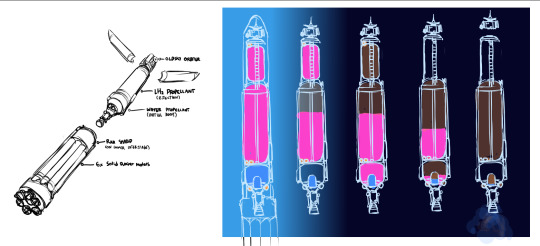
A launch vehicle I recall from home. I don't remember the name, but I'm sure "nuclear" was in there somewhere.
Here's what I told our friend Sofia about it.
left: overview of the entire launch vehicle. since i don't know mellanish anymore i don't know what it's called. Drawing a blank. Anyway. It's a nuclear rocket. The first stage is a cluster of solid rocket motors which gets the rocket flying fast and high and out of the thickest part of Gymnome's atmosphere, where the solid core nuclear thermal rocket can take over.
The rocket uses a water tank for propellant during stage 2A (the initial burn), because although the efficiency (Isp) is low for a waterlogged NTR, the thrust is as high as conventional hydrogen/oxygen chemical rockets but in a much smaller tank size. (this is because SCNTRs and Chemical rockets are both constrained in temperature to about the same amount, and so the thrust power is the same and all that can change is the mass flow rate.)
Once the rocket has accelerated up such that it no longer needs to worry about falling down, the vehicle can switch to Stage 2B, and start running hydrogen through the NTR. The thrust is lower, but the velocity gain per unit mass of fuel is much higher due to the fact that the hydrogen can be accelerated to a higher speed than the water. (with all that pesky oxygen).
It was noticed at some point that these rockets were really well suited for orbital refueling. This is still fairly early all things considered so that kind of infrastructre had been thought about a lot, but not actually built. The first time it was tried was in a sort of self contained way.
on the right you can see a diagram of the upper stage with a different payload, which I think was maybe used OH! I thought it was an ice giant probe or something but I bet this was from after the Zaldans left and the space program was rushing to figure out why, so they needed something to zip over to Oldsky around Omen real fast. Maybe. Point is, you need a small payload going very fast.
normally with an LH2/LO2 chemical rocket you would just build a small upper stage that can fit on top of the lower stage, and use that to kick the payload. But for whatever reason they decided to make good on the theoretical refuelability use case of the rocket stage in a goofy self-contained way.
They just added a hydrogen tank (which was actually straight off of an LH2/LO2 chemical rocket upper stage), and plumbed it into the water tank. They plumbed it into the water tank instead of the LH2 tank because, well probably partly just to show that they could. But also because of the ullage gas (shown in transparent orange in the diagram). Ullage gas, usually helium, fills up the empty part of a fuel tank to keep the propellant from boiling away as it's used. There's separate spheres of helium used for the job. With propellant still inside of the main hydrogen tank, but the water tank totally emptied (aside from the little reservoir used for cooling the reactor on startup and shutdown), it would be easier to force the hydrogen into the water tank than to simply refill the hydrogen tank.
at least, that was the theory.
it didn't work, but i don't recall why. If I had to guess, some component was overlooked when testing the water tank and associated plumbing's ability to work with frigid liquid hydrogen.
Anyway investigating Oldsky to figure out the disappearance of the Zaldans had to wait for the next Omen apparition.
#Gymnomi Rockets#Mellanoid Slime Worldbuilding#<- including this tag in these posts for parity with Luna's even though what i feel like i'm doing is more 'remembering' than 'creating.'#being a fictive is weeirrd.#space#spacecraft#spaceflight#rocket#launch vehicle#atomic rocket#nuclear rocket
11 notes
·
View notes
Text
Thanks to @galusandmalus I've fell into a rabbit hole of Greek Mythology again.
So basically they gave me this fragment extracted from Tatian's Address to the Greeks:
"To the Babylonians you owe astronomy; to the Persians, magic; to the Egyptians, geometry; to the Phoenicians, instruction by alphabetic writing."
What the hell do you mean by "magic", Tatian?!
So I've made a quick search and the very first (random) source related to this topic I've managed to find was from St. Jerome's account:
"Perseus fought against the Persians, holding the decapitated head of the licentious Gorgon, which on account of her extraordinary beauty so rendered the minds of her spectators impotent, that she was thought to turn them into stones; Didymus writes in his Foreign History, and exposes its author."
Excuse me, Perseus fought the persians? Really? I mean, SEARIOUSLY?!
For more context, it is believed that Perseus and Andromeda's very first child and son, Perseus, was left in Aethiopia to be raised by Cepheus and Cassiopea because Cepheus didn't have any male heir and life as prince cannot be so bad (especially when your father grew up either as a fisherman or slave).
So why would the persians, which very likely led by Perses giving the context, would want to fight Perseus? Was he angry that his father went to get the milk and his mother joined him? Was he angry that he never met his parents? Did Cepheus lied to Perses all this time and told him that Perseus was a horrible man because he was still pissed off by the fact that his daughter married him instead of his brother? This part is confusing, nervertheless.
Anyway, I then tried to search for a concrete source and finally found some informations about the persian magus, which kinda clarified my confusion a little. But here's thing is: the magi were priests in Zoroastrianism. And if you check the Malalas Chronography, you would find out that here Perseus was considered a wizard who killed Medusa for spells and potions, then ruled over Persia where he invented Zoroastrianism, and then after his accidental petrification his son Perses ruled over persians:
"They write that he had wings, because from childhood he was very quick-moving. Hence his father Picus Zeus taught him to perform and carry out the Manganeia [witchcraft] of the abominable cup (myseros skyphos), teaching him everything about mystic and impious errors. He told him that “You will defeat all warriors with this, your enemies and every man opposed, and everyone who looks at this face with be blinded and remain so until they are dead and slaughtered by you.” So Perseus was persuaded by his father Picus Zeus. In later times, after the death of his father Picus, when he had come to full age, he coveted the kingdom of the Assyrians, envying the children of Ninus, his uncle, the brother of his father. Having received a prophecy, he went to Libya. On the road a virgin, a village girl, met Perseus. She had wild hair and eyes. Standing in front of her he asked her, “What is your name?” She freely replied, “Medousa.” Holding her hair, with the sickle-spear sword he carried, he cut off her head. Perseus took it and immediately performed mystic rites on the head, as he had been taught by his father Picus the error of the hateful Manganeia."
[...]
When a winter storm came, and the river running past the city of the Ionitai, then called the Drakon and now the Orontes, was flooding badly, he asked the Ionitai to pray. While they were praying and carrying out the rites, a sphere of fire-lightning came down from the sky, which caused the storm to cease and the flow of the river to be contained. As they marveled, Perseus from that fire lit a fire, and kept it guarded. This fire he carried back to Persian territory, to his own kingdom, and he taught them to honor that fire, which he told them he had seen being brought down from the sky. The Persians continue to honor that fire as divine, up to the present day. Perseus built a sanctuary for the Ionitai, which he called “of the immortal fire.” He built in Persia, similarly, a fire sanctuary, installing pious men to minister to it, whom he called Magi. The very wise chronicler Pausanias has recorded this. After some time, King Cepheus, the father of Andromeda, came from Ethiopia to attack him. Cepheus couldn’t see, due to his age. When Perseus heard that he was attacking, he was furious, and went out against him carrying the head, and showed it to him.
Unable to see, Cepheus rode at him on horseback. Perseus didn’t know that he didn’t see, and concluded that the Gorgon head he was holding no longer functioned. So he turned it toward himself and looked at it. Blinded, he remained that way until he was killed. So then, the son of Perseus and Andromeda ruled over the Persians. He was appointed by his grandfather Cepheus, the king of Ethiopia. Cepheus commanded that the hateful head of the Gorgon be burned, and left for his own country. So the lineage of Perseus continued to rule the land of Babylonia.
Now, this book is both an unreliable source and one of those late ancient/early medieval texts that will tell about that one confusing myth you can find nowhere else in the original ancient muths and doesn't even make sense to begin with. But the fact that Perseus is considered here the inventor of Zoroastrianism along with the fact that his son Perses is considered the ancestor of persians and persians were also believed to have invented magic according to the greeks is some solid lore, I'm not going to lie.
10 notes
·
View notes
Text

Retconned Wardi firearms- a basic handgun, a highly decorative ceremonial handgun (belonging to Faiza), and a lance-gun.
Gun tech has officially been nerfed down to hand cannons (press F) (this has been a long time coming but I'd been fallacy of sunk costs-ing myself out of retconning).
Handguns are held similarly to a shotgun, with the butt pressed into the user's shoulder, one hand gripping under the barrel, and the other free to ignite the gunpowder. These represent the most advanced firearms in contemporary usage, both in make and in their use of uniform iron projectiles built to match the gun's bore for greater range and efficiency. Lance-guns are the more basal form, usually larger and mounted with the pole held over the shoulder, and are most effectively used by two people (one to hold and aim, one to light the gunpowder).
The spread of firearms is currently mostly limited to the Eastern Inner Seaway peoples (with some additional distribution via overland trade), and actual manufacture of hand cannons and gunpowder at Significant scale is limited to the region's core powers.
The reason for this limited spread is partially due to specific elements of the technology's history. Gunpowder was first synthesized by Burri alchemists and considered to be the discovery of the legendary divine weapon + solar fire of the deity Inanariya, and its formula (along with techniques for ideally refining its components) remained a closely guarded state secret. It was used predominantly in priestly contexts to generate flame and explosive sounds (in conjunction with earlier practices of generating multicolored flames with use of other chemicals), then integrated into combustible weaponry in the forms of fire lances, which would eventually develop into early handcannons.
The treatment of gunpowder as a guarded sacred or semi-sacred substance continued with Wardi adoption, where knowledge of its making is considered a closed rite. It's name (inya tsatsul or just tsatsul, a derived adoption of the Burri iñazatsūya) still reflects a divine solar association (the Burri word means 'sun's thunder', the Wardi 'inya' invokes the sun, 'tsatsul' is an adapted loanword and has no meaning independent of the substance itself), though its priestly use is now predominantly associated with the firearm'ed Odonii (rather than priests of the solar Face Inyamache). The composition of gunpowder can no longer be regarded as a Secret by any means, though efforts to obscure the methods of its creation are still moderately successful and has kept knowledge of gunpowder manufacture more limited than the total sphere of firearm usage itself.
The actual strongest limiting factor of firearm usage is the rarity of natural saltpeter deposits necessary for making gunpowder. The practice of actively producing saltpeter via nitraries has not been developed anywhere in the setting, and all is instead obtained via natural sources. These sources are rare and limited within the current spread of firearm technology, and result in gunpowder being a limited and expensive substance to produce. The weapons themselves are also very expensive to manufacture (a good quality steel SWORD is far too material-cost prohibitive for most people to own), particularly high quality firearms designed for use with standardized ammunition.
These guns are also very basal, and logistical difficulties in their use (weight, very slow loading and firing speed, high visibility, Relatively low reach and accuracy) along with the restrictive cost of production has kept firearms far from rendering conventional weaponry, armor, and projectiles obsolete (even within the societies that have access to them). They are still, however, very devastating in use within their contemporary context, particularly in that high quality guns have a longer range than the best arrow-based projectiles, and utterly negate most contemporary forms of armor at close range.
#I'd consider the setting to be like.....most closely analogous to like 3rd-1st century BCE earth (in terms of the average scale of#societies + Most of its technology (aside from major exceptions like this) + trade interconnectivity)#There are VERY few Very Big states capable of mass-manufacturing and resource extraction (like nothing the size of#the Roman empire has Ever existed in this setting. The biggest empires aren't even close. Cynozepal has a pretty massive territorial#span so is probably the closest thing but its actual control is highly fragmented along disconnected central hubs)#There's significant seaway trade connections but the Vast majority of transmission of goods is localized (even moreso over land)#So point being firearms have developed '''''earlier''''''' than in IRL history but the conditions that enabled very rapid spread are#not really present (though it's fairly inevitable that they'll become widespread over the next few centuries)#Also the likely trajectory of adaptation is going to be the development of Plate armor (which could absorb/block shots#from some types of firearms More advanced than these).#The types of armor used in this particular region is mostly lamellar/scale/padded fabric/leather and rarely involves#full body protection (using a shield to compensate) so developing thicker and fully protective armor would be the next logical#step in the arms race#I think it would be a fun constructed history for armor technology to outpace these simple firearms enough that they end up largely#abandoned in favor of re-specializing in close combat but I don't really care to plan out the far future that much
79 notes
·
View notes